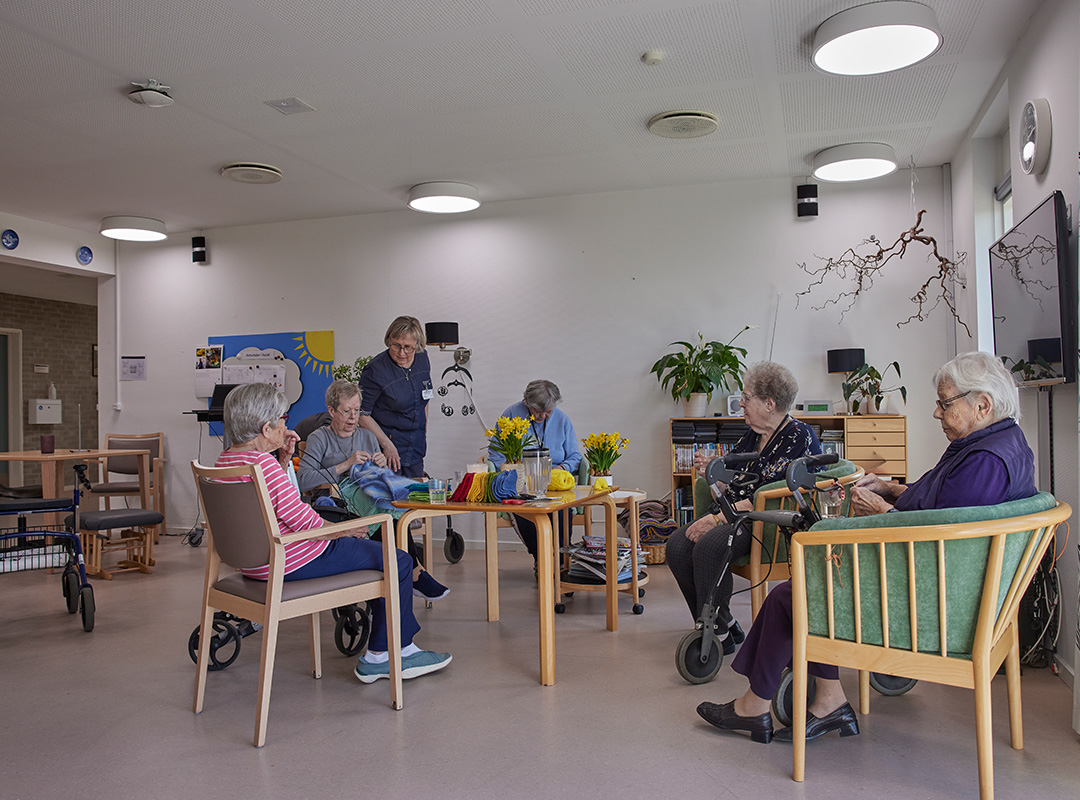Implementation, testing, and research on the effects of circadian lighting in the residences are in progress at Bauneparken Nursing Home.
The nursing home Bauneparken is part of the European project PerCiLight, which aims to improve lighting conditions in nursing homes. Research is an integral part of the project to ensure that the solution has the desired health impact that truly makes a difference. In connection with the scientific studies, Bauneparken participated in a baseline study where data was collected based on normal conventional lighting. Therefore, the residents and staff of Bauneparken, who are accustomed to having circadian rhythm lighting in their common areas and hallways, had their lights replaced with conventional static white light.
The baseline study is now over, and their circadian rhythm lighting has been turned on again. And it has truly been missed:
“We have definitely noticed that our lighting has been static for a period of 16 weeks; we have missed circadian lighting a lot. Several employees, especially evening and night shift workers, have expressed that they have been experiencing headaches and eye discomfort, similar to what they knew from the time before circadian lighting. Some of our residents have become more restless and get up at night, which they otherwise did not do with circadian lighting," says Gitte Ellekilde Andersen, Nursing Home Manager at Bauneparken Nursing Center, and continues:
"It shows the difference circadian lighting makes for our health and well-being - I wish that other nursing homes will also have the opportunity to try circadian lighting."
In addition to being back in circadian lighting in common areas and hallways, the PerCiLight project has moved into the next phase, where circadian lighting is implemented in a number of residences as part of the testing and evaluation of the products and the entire solution.

New lamps are intended to promote health and a sense of cozy homeliness
It is a core understanding that one lamp is not enough to provide the beneficial and health-enhancing effects. Circadian lighting needs to be approached holistically. Therefore, a range of lamps/luminaires that fit into a typical care home with all its rooms and functions has been developed in the PerCiLight project. At the same time, in order to support the health and well-being of the elderly residents, they all need to have a 'biological circadian' function.
The purpose of the project and the new lamps for the nursing home residence is to improve lighting and promote health. The lighting should support the natural circadian rhythm of individuals, providing energy during the day and promoting good, relaxing sleep at night. In several research projects, the beneficial effects of circadian lighting for nursing home residents and staff have already been proven, such as reduced sick leave and headaches among staff, and decreased medication usage, improved sleep, and reduced anxiety and depression among residents. By now also offering circadian lighting in residents' homes, the project aims to enhance the existing effects by eliminating the need for residents and staff to switch between circadian lighting and static lighting when moving between common areas and residences.
However, there are barriers to introducing new lighting into private homes, especially among elderly and dementia patients. There is a risk that residents will reject the new lamps if they do not fit into their existing homes, seem unnatural, are difficult to operate, and remove the cozy homeliness they associate with their own furniture and lamps in the room.
This imposes a number of requirements on the lighting and the design of the products, says Julia Hartmann from lightsphere in Switzerland, who is involved in the PerCiLight project as a lighting designer. She elaborates:
"It is crucial to consider not only the aesthetic appearance but also the psychological effect of light when designing appropriate lighting in care homes. This is often underestimated. Residents are used to lamps and luminaires having a certain appearance and effect and expect the same from new lighting. According to residents' understanding and experience, the primary light sources are a ceiling lamp, possibly floor and table lamps, and natural light from windows. The aim of the PerCiLight lighting design is therefore to aesthetically enhance the familiar lighting locations in order to achieve the highest possible level of user acceptance. These luminaires are complemented by additional luminaire units that support the natural lighting in the room and blend in seamlessly with the interior design to provide the best possible support for the beneficial effects of circadian lighting.
This means that the lighting should appear natural and, at the same time, create a sense of homeliness for the elderly nursing home residents to make it easier for them to accept the lighting.
The lighting in the residence is also for the staff
The PerCiLight project not only focuses on the residents but also extensively on the staff and the complex care environment. The focus on the staff is regarding their health and working environment, as well as their relationship with the residents. Nighttime nursing staff need to be able to check on the residents and there may be situations where they need to assist a resident during the night. In these cases, they require lighting for visibility and work, but it must not disturb the circadian rhythm of either the sleeping resident or themselves. Therefore, it is not feasible for them to turn on bright white light when they are with the residents; instead, the work lighting also follows the circadian rhythm.
"We have designed the task lighting for the staff in the residences so that they have the necessary light at night to carry out their tasks," says Julia, and continues, "It is a central part of the improvement of the lighting in the whole nursing home. They will find that they have a better working environment without disturbing or waking the residents unnecessarily".
Throughout the project, there has been a focus on designing the lighting in collaboration with the staff and based on the residents' perspectives to create a homely atmosphere, a good working environment, and intuitive use.
In operation and testing
A total of 20 apartments have had circadian lighting installed in the residences during the test period. During the next phase of the project, scientific studies will run to collect data based on the circadian lighting, which will be compared to the baseline study.
Furthermore, the overall solution and individual products will be continuously evaluated in relation to both the residents and the staff. It is important to determine whether the products are accepted as part of the decor and whether they provide the necessary light they are designed to deliver. At the same time, the overall solution and operation will be assessed, and adjustments, additional training, or other considerations will be made if necessary.
About the PerCiLight project
Five companies from Switzerland, Poland, and Denmark, along with a Danish nursing home, have joined forces to improve lighting conditions in European nursing homes. The project is funded by the EU program AAL - Ageing Well in the Digital World and is based on the recognized knowledge that light controls human circadian rhythms and affects our physical and mental well-being. Read more about the project here.


